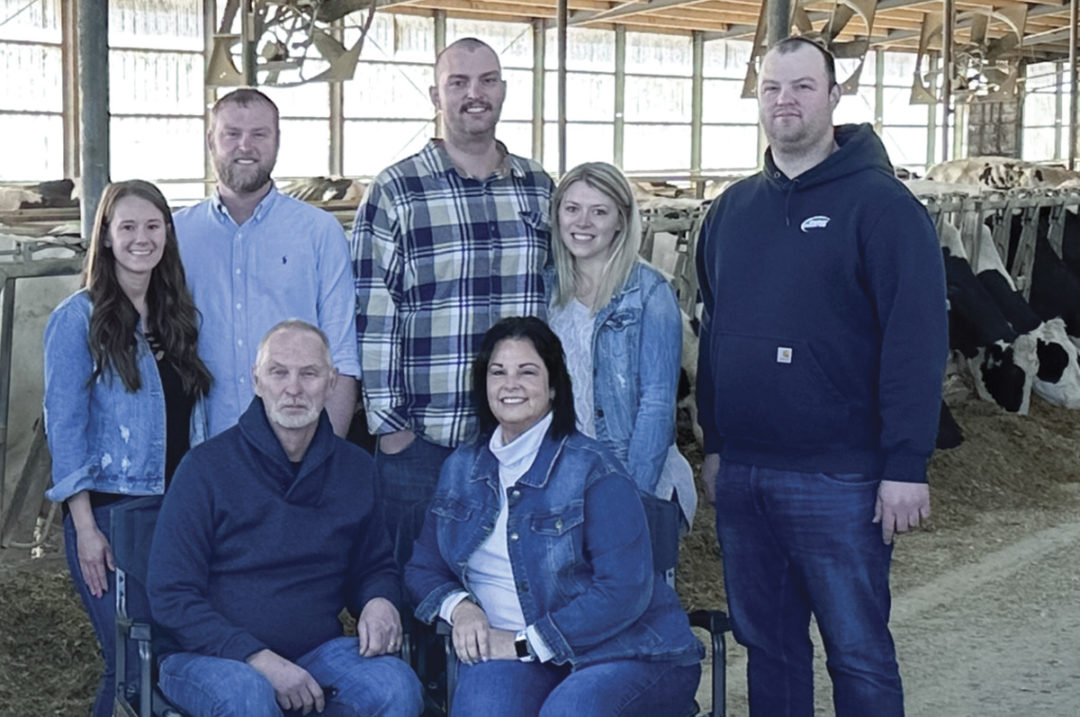How would your employees describe their experience working on your farm? What do they value most about working there? What would they change about their jobs?
These are some of the survey questions employees are asked when their dairy farm employer participates in the Phibro Animal Health Vital Insight program. The program provides tools and resources to dairy owners and managers to help them identify strengths and opportunities related to employee engagement, and build a plan to address and improve weaknesses. Approximately 1,600 employees on more than 55 dairies have completed the program, which is a partnership initiative between Phibro and Purdue University Center for Food and Agriculture Business.
“It is rewarding for us to see and hear the appreciation from employees after having the opportunity to contribute their thoughts on where and how the dairy can improve,” says Phibro representative John Frey. “The feedback process alone is empowering when dairy owners and managers use it as a springboard to make even small changes suggested by the employees.”
The program includes a comprehensive and anonymous employee assessment that helps dairy farm leaders identify what is working and what is not to ultimately create an attractive workplace for both current and future employees. The survey is provided in both English and Spanish and includes 65 questions – most of which are multiple choice – on the following topics: farm priorities, purpose and core values, management (direct supervisor), dairy ownership and leadership, communication and information sharing, employee pride, motivation and engagement, teamwork with coworkers and workplace safety.
Resources and coaching are provided to dairy owners and managers, including a pre-survey checklist and informational posters to place in appropriate locations around the dairy prior to survey day. The poster, which is provided in English and Spanish, includes answers to frequently asked questions related to the timeline, what the program is, why farm leaders are participating in it and how the process works.
“We talk about ‘survey day’ – or ‘Vital Insight Day’ – as an important day in the life of their dairy organization,” says Jacob Pieper, Phibro representative and Vital Insight team member. “Dairy owners and managers will come back to their team(s) within 30 to 60 days and share the findings, solicit additional input and communicate next-step priorities.”
The program team meets with farm employees in groups ranging in size from two to 20 for approximately 45 minutes.
“Our desire is to accommodate the dairy’s schedule and meet with multiple groups of employees throughout the day,” Pieper says. “On most dairies, this is easily completed in one day. The survey begins with an overview of the program and requires the dairy’s employees to consent to participate. We’ve had very few employees choose to refrain from participating as ultimately, each question is optional.”
Follow-up includes virtual and/or in-person meetings with the owner(s) and/or manager(s) of the farm to share findings and create an action plan. Farm owners and managers are also provided with tips for sharing findings with their employees.
Recommendations for improvement are based on responses to the lower-scoring questions when compared to peer employees on all farms who have been through the program. Recommendations are provided during the post-survey meetings with the Phibro team. Examples of recommendations include more one-on-one opportunities for individual employees to regularly meet with supervisors, more emphasis on employee growth and development, asking employees what skills they would like to learn, and providing more clarity and communication about what it takes to advance and what their career path could look like based on their interests.
Aside from utilizing Phibro products, several other factors contribute to whether a dairy is a qualified candidate for the program. Qualified farms should have a strong existing relationship with Phibro, have a plan in mind of how they envision using the information they learn from employee surveys and have an active leadership team that meets regularly to analyze, evaluate and make decisions.
Management objectives
The program also includes a management objective output component, which is the result of associating each question with one of five areas of dairy management – clarity, equipped, engaged, aligned and accountable. These objectives were chosen by Phibro and Purdue, along with feedback from program users and other interested external stakeholders. Program users receive a ranking, along with feedback, on each of these important areas of employee management.
“This aspect of the program provides dairy leaders an interesting perspective of where and how their team can improve management and leadership, as they work with their respective employee teams,” Pieper says.
Trends
The Phibro team, along with their partners at Purdue, have compiled responses from employees who have participated in the program thus far and discovered some trends.
In their responses, employees consistently said they were clear on the priorities, core values and mission of the dairy they worked for, and they were motivated and proud to tell others they worked there. Employee workplace safety is also an important survey category, according to the Phibro team. While on average it receives a high ranking, this is a category that each dairy analyzes closely for improvement opportunities and includes in post-survey meeting priorities.
On the other end of the spectrum, the areas of communication and feedback consistently scored lower among surveyed employees. While language can be a barrier, some common opportunities for improvement include poor organizational structure and inconsistent meeting schedules, along with lines of communication that were not open for feedback. However, a question asking if employees were comfortable talking with their supervisor ranked high, suggesting that it may be situational.
Questions with the lowest-ranking responses included:
- “Dairy owners/leaders communicate openly with me.”
- “Supervisor asks my thoughts on decisions that impact my job.”
- “There is a family or team feeling at the dairy.”
Leadership mindset
The program team says that the mindset of the dairy owner or manager is important and influences how they receive employee feedback provided through the program.
“Each dairy that has gone through the Vital Insight program considers employee feedback as a vital component of their journey to becoming a high-performing and healthy dairy organization,” Frey says. “Additionally, morale, motivation and pride suffer when employees do not understand how their work contributes to the dairy’s overall success and vice versa.”
Other key learnings suggest that a clear structure and overall sense of comradery are important, along with consistent two-way communication of expectations, core values and feedback.
Producer perspectives
Brady Weiland from Weiland Farms in Wisconsin says that participating in the program was a “very rewarding experience.”
“There is always some fear when we as team leaders are ‘evaluated’ by our team, but overall, it was rewarding to see that we are above average in many areas,” Weiland says.
Survey results provided insight into their team’s thoughts about working for the Weiland family and with their fellow team members.
“The [survey] results showed us that our staff very much enjoyed working for our family but did not like working with their fellow team members. They felt there was a lack of teamwork, which was mind-blowing to us, [since] we have had little to no turnover within our staff of 18,” he says.
At Weiland Farms, management changes stemming from survey results improved overall morale.
“We found that we needed to do a better job holding team members accountable who were not doing their jobs correctly,” he says. “In return, [this created] more trust and respect within the team. Knowing they can count on each other to do the job has really changed the overall morale. We are encouraging the staff to communicate directly with each other rather than always going through a supervisor or owner when they have a conflict or need help.”
They also revised their performance review process and created more opportunities for team building by hosting cookouts in the summer and fall, celebrating with a team Christmas party and holding monthly team meetings.
“We have always done performance reviews with our team members, but we tweaked the process to a simpler one focused on three key areas: respect, productivity and safety,” Weiland says. “Additionally, to help with comradery, we also coached our manager and herdsmen on how to positively interact with team members.”
Another dairy farm on the east coast agrees that employee relations improved after participating in the program. Don Jensen III from Lawnhurst Farms in New York completed the program three years ago and says the survey results show how well dairy owners and managers are aligned with their employees.

Don Jensen III says the most rewarding part of the program was getting their employees involved and having some fun with it. He is a partner in Lawnhurst Farms along with his dad, Don Jensen II, and sister, Kelley.
Pictured: (Left to right) Kelley Jensen holding her niece, Audrey, who is the daughter of Don Jensen III; Don Jensen III; Ann and Don Jensen II. Courtesy photo.
“[Our employees] responded really well [to the program], and it was fun,” Jensen says. “It really puts the rubber to the road when you look at this and ask, ‘How good of a job are we doing? Are our employees thinking along the same lines as we are thinking? What kind of blind spots do we have? Are we on the right track with things? Where do we need to make improvements?’”
Reviewing survey results was “eye-opening,” and Jensen says that, while they knew they had a good relationship with their employees, the survey showed it was even better than they thought and they were “very much aligned with [their] team.”
“Communication with middle managers is an area that has improved since participating in this program,” he says. “Before we make changes that are going to affect them and the people they are overseeing, we know we need to get their feedback and make them part of the discussion. Sometimes, they think of things that we may not have thought of.”
In addition to seeking employee feedback, the Lawnhurst team became more intentional about developing and communicating the purpose of the operation and the farm’s core values to employees.
“We have them in our head, and we live them every day, but we needed to get them [on paper] so our employees can see them and so prospective hires can understand what our farm is all about,” Jensen says.
When asked about their motivation for participating in the program, the answer was abundantly clear: They did it for their employees.
“Our employees are our most valuable asset, and we think of them as family, so getting them involved was important because we can look at this and say, ‘Well, this is what we think,’ but their involvement is a big reason why we did this,” Jensen says.






